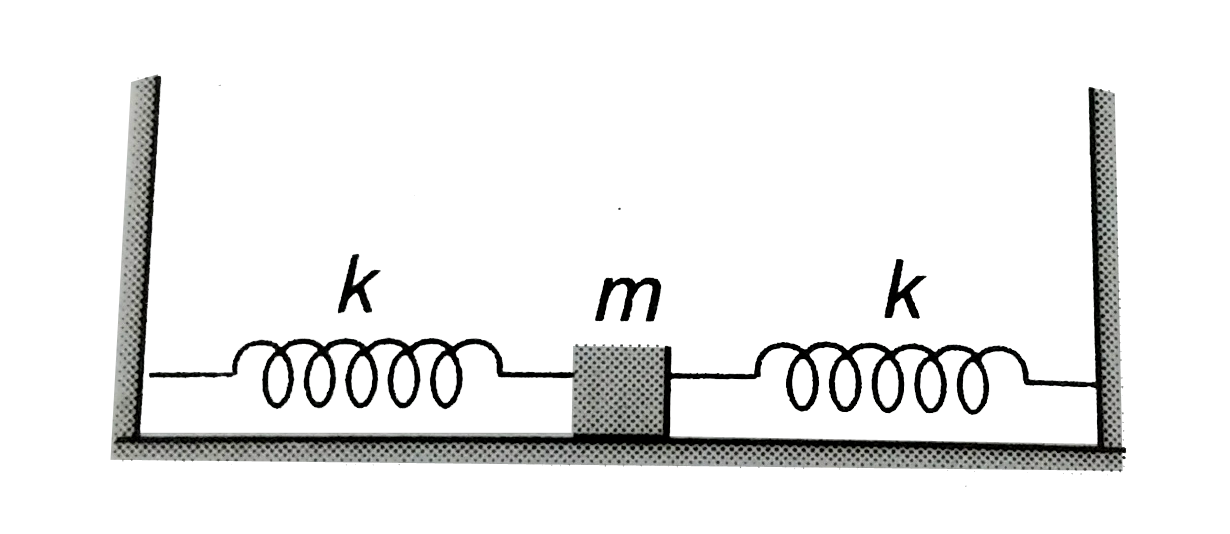A block is executing simple harmonic motion of amplitude on a smooth horizontal surface under the restoring force of a spring of spring constant . A block of mass is gently placed on it at the instant it passes through the mean position. Assuming that the two blocks move together. Find the frequency and the amplitude of the motion.
To solve the problem step by step, we will calculate the frequency and amplitude of the motion after a 3 kg block is placed on a 1 kg block executing simple harmonic motion.
Step 1: Calculate the initial frequency of the 1 kg block
The formula for the frequency f of a mass-spring system is given by:
f=12π√km
where:
- k=100N/m (spring constant)
- m=1kg (mass of the block)
Substituting the values:
f1=12π√1001=12π√100=102π=5πHz
Step 2: Calculate the new frequency after placing the 3 kg block
When the 3 kg block is placed on the 1 kg block, the total mass becomes:
mtotal=1kg+3kg=4kg
Now, we can calculate the new frequency f2:
f2=12π√kmtotal=12π√1004=12π√25=52πHz
Step 3: Use conservation of momentum to find the new amplitude
At the mean position, the maximum velocity of the 1 kg block is given by:
v1=ω1A1
where:
- ω1=2πf1
- A1=0.1m
Calculating ω1:
ω1=2π(5π)=10rad/s
Now, the maximum velocity v1:
v1=10×0.1=1m/s
For the combined mass (4 kg), the maximum velocity v2 is:
v2=ω2A2
where ω2=2πf2:
ω2=2π(52π)=5rad/s
Using conservation of momentum:
m1v1=m2v2
Substituting the values:
1×1=4×A2⋅5
Solving for A2:
1=20A2⟹A2=120=0.05m
Final Results
- The new frequency f2 is approximately 52π≈0.8Hz.
- The new amplitude A2 is 0.05m.
- k=100N/m (spring constant)
- m=1kg (mass of the block)
- ω1=2πf1
- A1=0.1m
- The new amplitude A2 is 0.05m.
Topper's Solved these Questions
- SIMPLE HARMONIC MOTIONBOOK - DC PANDEY ENGLISHCHAPTER - SIMPLE HARMONIC MOTIONEXERCISE - Exercise 14.1
5 Videos
- SIMPLE HARMONIC MOTIONBOOK - DC PANDEY ENGLISHCHAPTER - SIMPLE HARMONIC MOTIONEXERCISE - Intro. Exer.
1 Videos
- SIMPLE HARMONIC MOTIONBOOK - DC PANDEY ENGLISHCHAPTER - SIMPLE HARMONIC MOTIONEXERCISE - Level 2 Comprehension
2 Videos
- SEMICONDUCTORS AND ELECTRONIC DEVICESBOOK - DC PANDEY ENGLISHCHAPTER - SEMICONDUCTORS AND ELECTRONIC DEVICESEXERCISE - More than One Option is Correct
3 Videos
- SOLVD PAPERS 2017 NEET, AIIMS & JIPMERBOOK - DC PANDEY ENGLISHCHAPTER - SOLVD PAPERS 2017 NEET, AIIMS & JIPMEREXERCISE - Solved paper 2018(JIPMER)
38 Videos
Similar Questions
A 1kg block is executing simple harmonic motion of amplitude 0.1m on a smooth horizontal surface under the restoring force of a spring of spring constant 100N/m. A block of mass 3kg is gently placed on it at the instant it passes through the mean position. Assuming that the two blocks move together. Find the frequency and the amplitude of the motion.
View SolutionBlock A of mass m is performing SHM of amplitude a. Another block B of mas m is gently placed on A when it passes through mean position and B sticks to A. Find the time period and amplitude of new SHM.
View SolutionA block of mass m1 resting on a frictionless horizontal surface is connected to a spring of spring constant k that is anchored in a near by wall. A block of mass m2 is placed on the top of the first block. The coefficient of static friction between the two blocks is μ Assuming that the two blocks move together as a unit, find the period of oscillation of the system and also find maximum oscillation amplitude that permits the two bodies to move as a unit.
View SolutionA block of 10 g slides on smooth horizontal surface with 20 m/s towards a spring of spring constant 100 N/m placed horizontally (as shown in figure). The maximum compression in spring is

View SolutionA paricle of mass 30kg executes a simple harmonic motion. The restorting force is provided by a spring of spring constant 80N/m. Find the time period.
View SolutionA particle of mass 200g executes a simple harmonic motion. The restoring force is provided by a spring of spring constant 80N/m. Find the time period.
View SolutionTwo blocks A and B of mass 16kg and 64kg are placed on a smooth horizontal surface. Blocks are connected by a spring of spring constant 100N/m. Find the ratio of maximum speed of block A to maximum speed of block B.

View SolutionA block of mass m moving with velocity v0 on a smooth horizontal surface hits the spring of constant k as shown. The maximum compression in spring is

View SolutionA block of mass 0.5 kg hanging from a vertical spring executes simple harmonic motion of amplitude 0.1 m and time period 0.314s. Find the maximum fore exerted by the spring on the blockl.
View Solution
A block of mass m is attached to two unstretched springs of spring constant k, each as shown. The block is displaced towards right through a distance x and is released The speed of the block as it passes through the mean position will be
View Solution
